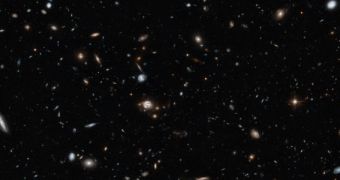Astronomers operating the NASA/ESA Hubble Space Telescope recently pointed the famous observatory towards a patch of the night sky and exposed its sensitive detectors to the incoming light for 14 hours. This allowed the team to collect data on objects about 1 billion times fainter than what can be seen with the naked eye.
The image above exemplifies what is known as a cross-section through the Universe, since it contains thousands of galaxies, spanning billions of years into the past. This allows astronomers to see galaxies at various stages during their development process which, in turn, enables them to reconstruct the evolutionary history for many of these objects.
The farthest objects in this image are up to 7 billion light-years away, meaning that we see them as they appeared when the Cosmos was just half of its current age. The majority of galaxies visible above lie around 5 billion light-years away, while some are located even closer to the Milky Way. Due to the extreme distances involved, some of the background galaxies appear to be distorted.
This is due to gravitational lensing, a process through which the gravitational pull of a galaxy located between Earth and another, far more distant galaxy, bends the light emitted by the latter. In effect, the galaxies in between Hubble and galaxies located farther away act like lenses in space, distorting the view, but also amplifying the small amount of light the distant observation targets release.

 14 DAY TRIAL //
14 DAY TRIAL //